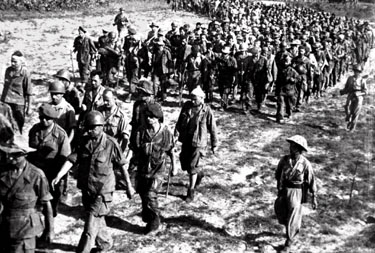Exit of the French, 1950-1954

During January 1950 the communist countries who were led by the People's Republic of China (PRC) recognised the Viet Minh's Democratic Republic of Vietnam (North Vietnam) based in the city of Hanoi as the rightful government of Vietnam and the non-communist countries recognised the French backed State of Vietnam led by the former Emperor of Vietnam Bảo Đại based in the city of Saigon now called Ho Chi Minh City as the rightful government of Vietnam the following month, because of the outbreak of the Korean War in June 1950 Washington policy makers were convinced that the war that was currently going on in Indochina was an example of communist expansionism directed by the Kremlin in the Soviet Union led by Joseph Stalin (1878-1953). Military advisor's from the People's Republic of China started assisting the Viet Minh in July 1950, because of the PRC weapons, expertise and labourers the Viet Minh were transformed from a guerilla force into a regular army. And in September that year the United States created a Military Assistance and Advisory Group (MAAG) to screen French requests for aid, advise on strategy and to train Vietnamese soldiers, by 1954 the United States had supplied the French with 300,000 small arms and had spent $1 billion U.S. in support of the French military effort in Indochina, this was 80% of the cost of the war. There had also been talks between the French and the Americans about the possible use of three tactical nuclear weapons, one version of this plan was called Operation Vulture which envisioned sending 60 Boeing B-29 Superfortress Bombers from the U.S. bases that were in that region, these bombers were to be supported by 150 fighters launched from U.S. Seventh Fleet carriers, the B-29's were to bomb Viet Minh commander Võ Nguyên Giáp's positions, Admiral Arthur William Radford who was the chairman of the U.S. Joint Chiefs of Staff gave this nuclear option his backing. During the negotiations U.S. aircraft carriers sailed to the Gulf of Tonkin and reconnaissance flights were conducted over Dien Bien Phu. U.S. President Dwight D. Eisenhower made American support contingent on British support, but London was against such a venture. Eventually Eisenhower got convinced that the political risks outweighed the possible benefits of intervening so he decided against it.
The Soviet Union as well as the PRC gave crucial support to the Viet Minh. Support from the PRC in the Border Campaign of 1950 allowed suplies from them to come from them into Vietnam, through out the conflict U.S. intelligence estimates remained doubtful of French chances of success. The Battle of Dien Bien Phu marked the end of France's involvement in Indochina (Vietnam), Vo Nguyen Giap's Viet Minh gave the French a stunning military defeat and on the 7th of May 1954 the French Union garrison surrendered to them. Out of the 12,000 prisoners taken by the Viet Minh only 3,000 survived. The French negotiated a ceasfire agreement with the Viet Minh at the Geneva Conference (1954), and as a result independance from the French Union was granted to Cambodia, Laos and Vietnam.

No comments:
Post a Comment